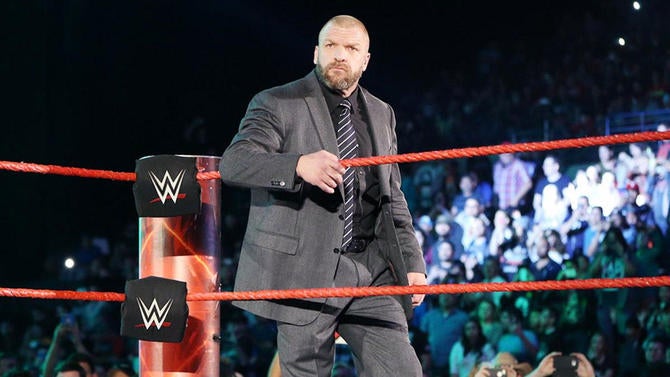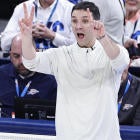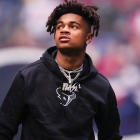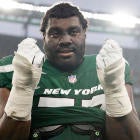In order to separate the unique roles that Paul Levesque holds within WWE, he has used a pair of on-screen nicknames that best describe the contradictory nature of his intentions.
When he’s Triple H, the 14-time WWE world champion who has main-evented WrestleMania seven times, he refers to himself as “The Destroyer.” Other times, when he appears on television in his corporate role as WWE’s executive vice president of talent, live events and creative, he goes by the moniker “The Creator.”
In a way, there’s a bit of irony to Levesque’s duel job titles entering WrestleMania 33, which airs live Sunday on WWE Network at 7 p.m. ET from Camping World Stadium in Orlando, Florida.
Through his work with WWE’s developmental brand, NXT, and the company’s state-of-the-art performance center, Levesque is the man most responsible for creating the young talent who will largely be featured Sunday. He’s also part of an aging group of performers from past generations who are strategically placed high up on the card to ensure it sells to the more casual fan. These are spots that, ideally, would go to superstars in their primes.
To steal the popular phrase often used by Levesque’s real-life wife, Stephanie McMahon, and her father, chairman Vince McMahon, it all comes down to “what’s best for business” for WWE.
“First of all, it’s ‘business’ being the key, so you want to make sure that you sell out a stadium,” Levesque said. “You want to make sure you do the most business that you can do with it so you’re putting the most on the card that allows you the biggest business.”
Levesque, 47, who had his first WWE match in 1995 as Hunter Hearst Helmsley and hasn’t stopped climbing the company’s ladder since, will join “Attitude Era” contemporaries Goldberg, The Undertaker, Shane McMahon and Chris Jericho as featured in-ring attractions on Sunday.
As Levesque sees it, putting together a WrestleMania card is no different than programming Monday Night Raw or SmackDown Live each week: It comes down to appealing to the most people you can by having a little something for everybody. Putting too much stock into which match goes on last, he said, is a waste of time as long as you enjoy the show.
“We’re giving that platform to so many [young wrestlers] and they will boil up over time,” Levesque said. “I didn’t headline a WrestleMania in my first time either. I didn’t close the show and neither did [Steve] Austin or neither did The Rock. It takes time and people forget that. Then, when they boil up and when they get in that position, it seems like all the other stuff went away.”
Triple H’s return to Raw on Jan. 30 reignited his feud with Seth Rollins and the WWE’s flagship show right along with it on so-called Road to WrestleMania. But it also ended a puzzling five-month stretch where Levesque was criticized for not appearing once on Raw despite literally handing the WWE universal championship to Kevin Owens last August before he disappeared, creating a major plot hole.
With the ability to instantly raise the property value on Raw in ways that few can outside of part-time star Brock Lesnar, Triple H’s return has been well-received. The March 14 promo he cut on now former general manger Mick Foley was one of Raw’s best recent moments, which begged the question: Why did he disappear in the first place?
“First of all, that’s very flattering, right?” Levesque said. “But at the same time, you want to give talent, and the younger talent, opportunities at all times. I have a different role now. Yeah, I can come on the show, I can do things here and there. Same with Foley, he’s great on the show. There’s a different intensity when a Goldberg or Brock Lesnar comes on there. But they can only do what they can, and they won’t do it all the time.”

Levesque believes his calculated time away from the cameras, which has allowed him to focus on his corporate duties, also provided opportunities for younger talent to step up in key spots.
“Look, I hope we get to a time where all those [young] guys, they are what it’s about and you don’t need to bring in these other things,” Levesque said. “And when you do bring in this older stuff that’s more experienced, you don’t see a difference. It’s just there. But I think when you don’t see a difference anymore you won’t see those guys anymore and they won’t be on the show.”
That’s where NXT and the WWE Performance Center come in. It’s a topic that brings out an almost paternal response from Levesque, who played such a huge role in the former’s creation in 2012 and the latter’s opening the following year.
Levesque, a wrestler who began his career during the dying days of the old territory system, looked around one day and realized the next generation’s superstars had nowhere to properly ply their craft and develop their overall skill set. Four years later, the subsequent impact of both NXT and the performance center on WWE’s in-ring product has been immeasurable.
“It has absolutely transformed WWE,” Levesque said. “I think there’s no other way to say it for me. When we did the [brand extension] draft [last July], 80 percent of the people drafted came directly out of the performance center and NXT.”
Part college and part boot camp, Levesque compares graduating through the company’s developmental system and making the main roster to “going to WWE 101.” He admits it can be incredibly overwhelming for the talent.
Not only was the developmental process created to cultivate characters and prepare superstars for the bright lights, the system has helped WWE from a wellness standpoint in terms of teaching healthy habits early in hopes of extending careers.
“When you come to the performance center, you’re immersed in what we do,” Levesque said. “I always say that what we are doing with the strength and conditioning and the rehab/prehab component is we are trying to make them bulletproof. Obviously you can’t do that, but you are trying to make them as healthy as possible.”
What that entails -- outside of teaching young wrestlers the fine art of sports entertainment -- is important life skills training in areas like nutritional counseling, financial advising, language skills and assistance in earning college degrees.
“When you get to the main roster, then the workouts are on you,” Levesque said. “But we hope we have instilled in you the right knowledge and the right mentality that you want to continue doing those things so that you can be healthy and can have a longer career. We can’t make anybody take care of their finances, but we hope we have given you all the tools and information to be successful.”
Levesque has been mindful of avoiding a system which, in trying to too hard to indoctrinate each superstar into “the WWE way,” creates a homogenized roster that has everyone sounding and wrestling the same. To do that, he has actively moved away from the recent WWE style of scripting everything for its superstars. The idea of being less hands on over every finite detail has helped performers take ownership of the character they are portraying.
“What we try to do is we try to give them direction,” Levesque said. “But we try to get them to do it. We want them to develop the character. We want them to find the voice for that character. We let them put matches and the physicality together. We let them figure out the promos.
“That’s really where it comes out to letting people be charismatic of their own accord and letting them figure out what it is.”
Levesque has also spoken about a future in which NXT is no longer seen from the outside as a developmental brand. To further that vision, he has discussed with Vince McMahon creating a sort of two-way street where main roster talent can return to platforms like NXT or any of WWE’s shoulder tournaments on the WWE Network without it being received as a demotion.
“Having these different platforms where talent can go and get off the merry-go-round and kind of go reboot and recreate themselves to give them new life and maybe get back in the mix, I absolutely think that is [important],” he said.
“I think the great thing about it is, when you talk about NXT, it’s not saying, ‘Oh, we are going to send you back to the minors.’ [Instead] it’s, ‘We are going to switch you over to this brand and in this brand you are still doing very well for yourself. You got your own [merchandise] still, you got your own platform, and you’re doing really well.’ It’s not necessarily a downgrade.”
NXT superstars will get their own platform this Saturday, one night before WrestleMania 33, when NXT TakeOver: Orlando invades the Amway Center with NXT champion Bobby Roode facing Shinsuke Nakamura in the main event.





















